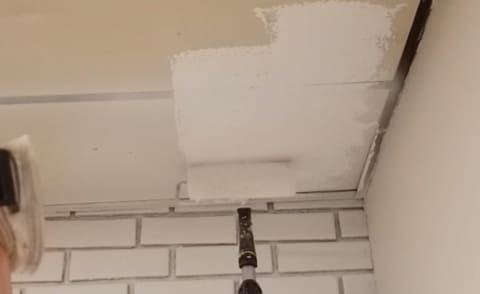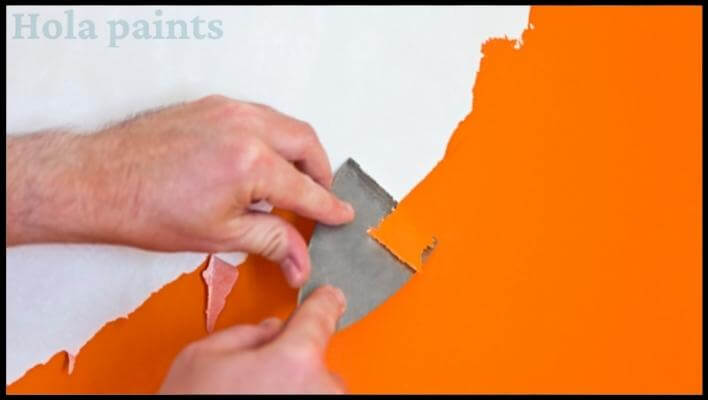Ceiling tiles are often underestimated in interior design. However, they play an important role in defining the aesthetic appeal of a room. A fresh coat of paint can enhance the brightness of the space and create a cozier ambiance. However, many homeowners and decorators ask whether it is possible to paint ceiling tiles. The Short answer is Yes. However, painting the ceiling tiles is different from painting the wall. The paint type will be different, and so will the process.
To further find out about painting ceiling tiles, how you can do it, what are the different creative ways to make your old ceiling look aesthetic and to get other answers to your questions, let’s get into today’s discussion!

Table of Contents
- How Can You Paint Ceiling Tiles Like a Pro: Steps to Follow
- Step 1: Gather Your Supplies
- Step 2: Set Up the Room
- Step 3: Prepare the Paint
- Step 4: Apply the Paint
- Step 5: Clean Up
- How do you make old ceiling tiles look better?
- 1. Paint the Ceiling Grid
- 2. Use Drywall
- 3. Give a Sonic Style
- 4. Cover with Wood
- Can I Paint Ceiling Tiles Without Taking Them Out?
- Is painting ceiling tiles a fire hazard?
- Painting Ceiling Tiles Safely
- Summing Up
- FAQs On spray paint ceiling tiles
- 1. Can you paint a fake tile board?
- 2. Which paint is best for covering ceiling tiles?
- 3. Can I paint PVC ceiling tiles?
- Martina Hitchcock
How Can You Paint Ceiling Tiles Like a Pro: Steps to Follow
Are you ready to paint your ceiling tiles like a professional? To give a beautiful makeover, you need careful preparation and proper instructions to follow.
Step 1: Gather Your Supplies
The first is gathering all the necessary supplies, like painting the tiles. It includes:
- Paint
- Ceiling Sprayer, roller and brush
- Safety goggles, gloves, and mask
- Cleaning materials like warm water, soap, and a cloth
- Painter’s tape
- Primer
- Tarp or Drop Cloths
Step 2: Set Up the Room
Next, place a tarp or protective drop cloths on the floor and furniture to prevent any paint drips from causing damage. Then, clean the tiles using water, soap, and washcloth. Allow them to dry thoroughly.
When it comes to ceiling painting, applying painter’s tape to protect moldings, trims, and any areas you don’t want to paint is important. And if you are dealing with a drop ceiling, use furring strips to prop up the tiles.
Step 3: Prepare the Paint
To choose the paint, some homemakers go for All-in-One Primer and Paint. However, others choose separate primer and paint products. If we talk about what is a reliable paint for ceiling tiles, I suggest flat-latex or water based paint. Acrylic paint can also work, but be sure it suits your tile material.
Step 4: Apply the Paint
Now start painting. Pour paint into a roller pan and slightly dampen the roller into it. In the below picture, I was using roller to paint basement ceiling.

Begin in one corner and paint horizontally from the outside towards the center of the ceiling. Overlap each stroke slightly to ensure even coverage.
Here’s a helpful resource that will help you paint a ceiling with a spray gun in detail and get a quick result.
Step 5: Clean Up
At the end, use a nylon brush for touch-ups. Make sure you carefully remove the painter’s tap. Then, clean up the painting mess.
How do you make old ceiling tiles look better?
You would find many ways to make old ceiling tiles look better. Here are a few décor ideas that will help you improve the tiles’ general appearance.
1. Paint the Ceiling Grid
To paint the ceiling grid, paint the metal grid and the tiles at different times. It will affect the sound properties of the tiles. Cover the tiles and light fixtures with tape and newspaper. You can also just remove the tiles altogether. This little DIY will help you update your space’s look without costly renovations.
In case you are interested in painting popcorn ceiling with sprayer, here is a complete guide.
2. Use Drywall
To hide a suspended ceiling, you can also use a drywall. It provides a smooth finish and also enhances the aesthetics of the space.
In this lovely area, the drop ceiling is expertly concealed with drywall that amazingly blends with the adjacent walls.
3. Give a Sonic Style
When it comes to acoustic tiles, people often wonder, can they paint acoustic ceiling tiles? They asked this question because they wanted to improve the aesthetic of the room but not compromise its acoustic performance.
You can indeed paint the acoustic tiles. Use an Acousti-coat, a flat water-based paint (latex paint) commonly used for this purpose.
4. Cover with Wood
If you rent your place and want to cover old drop ceiling tiles, use thin wood sheets or sticky wood veneer to cover the existing tiles. Wood makes the space look classy while maintaining accessibility.
Popular designer Sarah Barnard recommends using wood paneling to get a stately look while keeping the underlying elements of your drop ceiling easily accessible.
Can I Paint Ceiling Tiles Without Taking Them Out?
Yes, it’s feasible to paint ceiling tiles without needing to remove them. While it will take more time, you will get clean and visually appealing results. First, gather all the material you need, like:
- Furring strips
- A roller
- A paint tray
- A large paintbrush
- Paint suitable for ceiling surfaces
First, prop up a few ceiling tiles using furring strips. Then, use a large paintbrush to paint the edges of the ceiling tiles and the frame. Allow the paint to dry completely. Once the paint is thoroughly dry, carefully lower the ceiling tiles back into their original positions within the framework.
At last, use a roller and a paint tray to apply paint to the middle of each ceiling tile.

Pro Tip: Consider the direction in which you roll the paint. Think about where natural light hits the room and where people will likely stand or view the ceiling. By rolling perpendicular to the light source or predominant viewing angles, you can minimize the appearance of lap marks and flashing.
Is painting ceiling tiles a fire hazard?
When you paint ceiling tiles properly using the correct materials, it shouldn’t create a substantial fire risk. Nonetheless, it’s important to ensure safety seriously. Here are some key points to remember to minimize the risk of fire hazards.
Painting Ceiling Tiles Safely
Use Fire-Resistant Paints:
Choose paints specifically designed to resist flames and high temperatures. It is essential to use these paints to reduce fire risks.
Avoiding Thick Coats:
When painting ceiling tiles, don’t apply too much paint. Thick layers can compromise tile fire resistance. Follow the paint manufacturer’s instructions regarding the recommended thickness.
Preserving Fire Ratings:
Check that your ceiling tiles’ fire rating will not be compromised by painting them. If you are unsure, check with the manufacturer’s documentation or consult a fire safety expert.
Keeping Safety Devices Accessible:
Don’t block or paint over sprinklers, fire alarms, or other fire safety devices on the ceiling. These must remain unobstructed and fully functional to respond to fires.
Proper Ventilation:
Ensure good airflow while painting. Proper ventilation helps dissipate fumes and reduces the chances of heat buildup.
Regular Maintenance:
After painting the ceiling tiles, regularly inspect them and the paint for damage or wear. If you notice any areas that seem to be deteriorating, address them promptly to maintain safety.
Adherence to Building Codes:
Always follow local building codes and fire safety regulations. These codes exist to keep you and your property safe, so compliance is important.
Summing Up
Painting ceiling tiles is not only possible but also an effective way to update the look of your space. You can confidently get impressive results by following the steps and tips I shared today. Just decorate your ceiling tiles to see how they will add beauty and enhance the overall atmosphere of your room.
FAQs On spray paint ceiling tiles
1. Can you paint a fake tile board?
You can paint fake tile boards, such as faux wood or laminate panels. Clean, sand, prime, and paint.
2. Which paint is best for covering ceiling tiles?
The suitable paint for concealing ceiling tiles varies depending on the tile material. In most cases, water-based latex paint is a popular option for ceiling tiles. It’s user-friendly, dries rapidly, and doesn’t produce strong fumes.
3. Can I paint PVC ceiling tiles?
Yes, you can paint PVC (polyvinyl chloride) ceiling tiles. PVC is a relatively easy material to paint.
- Clean and prime the tiles.
- Use high-quality latex or acrylic paint suitable for PVC.
- Apply multiple thin coats.

Martina Hitchcock
Martina Hitchcock is a versatile author with expertise in different fields. As a paint sprayer expert, she has in-depth knowledge of paint spraying techniques, tools, and equipment. Martina is also an experienced home remodeler who has worked on various projects, including kitchen and bathroom renovations, flooring installations, and room additions. Her knowledge of home improvement and remodeling is extensive, and she enjoys sharing her insights and tips with readers. You can follow her on Facebook.


